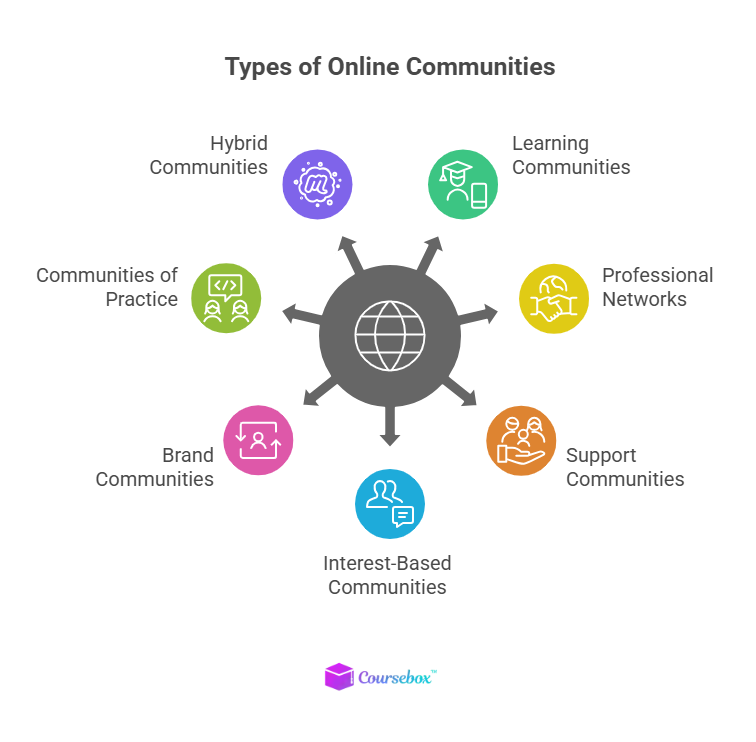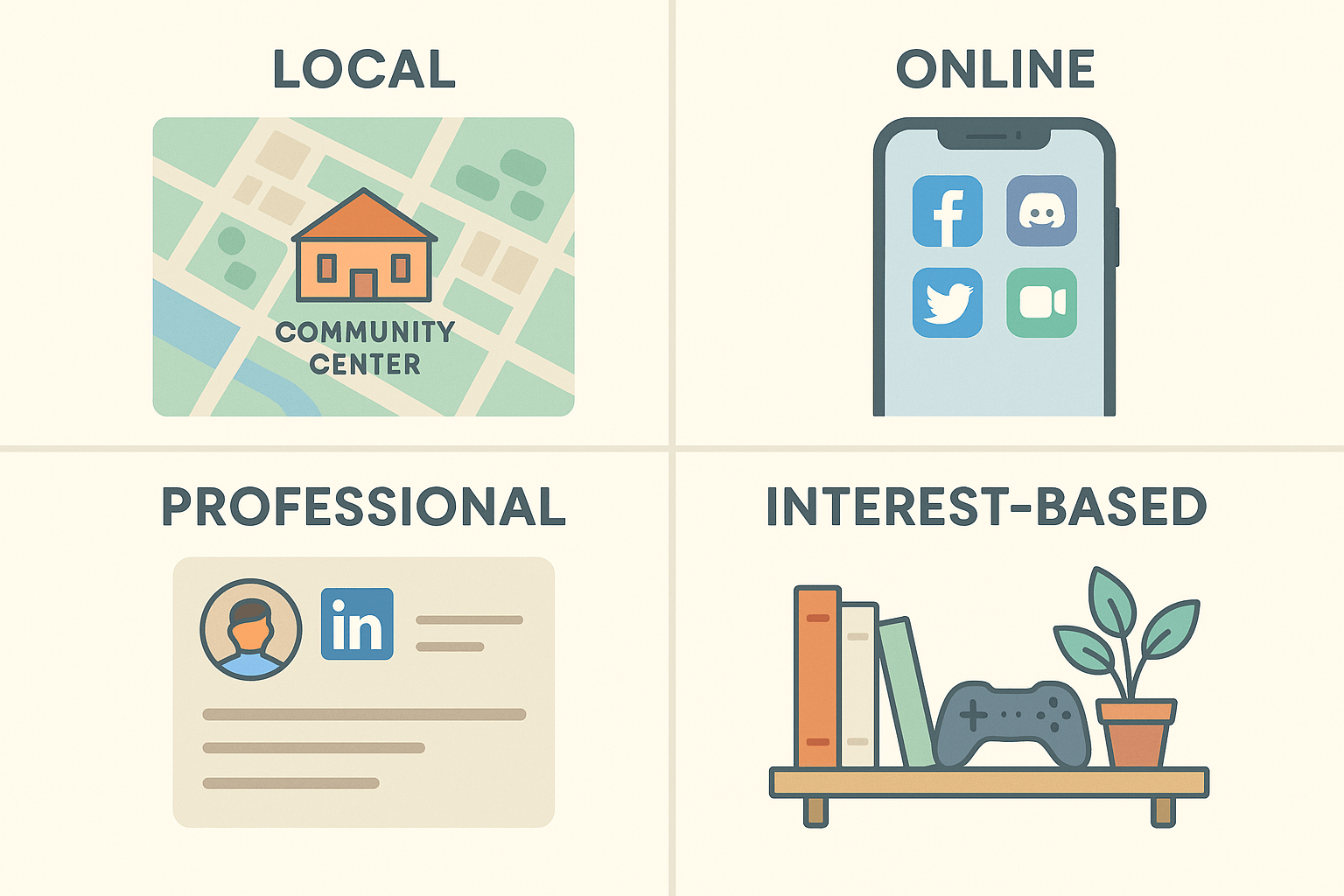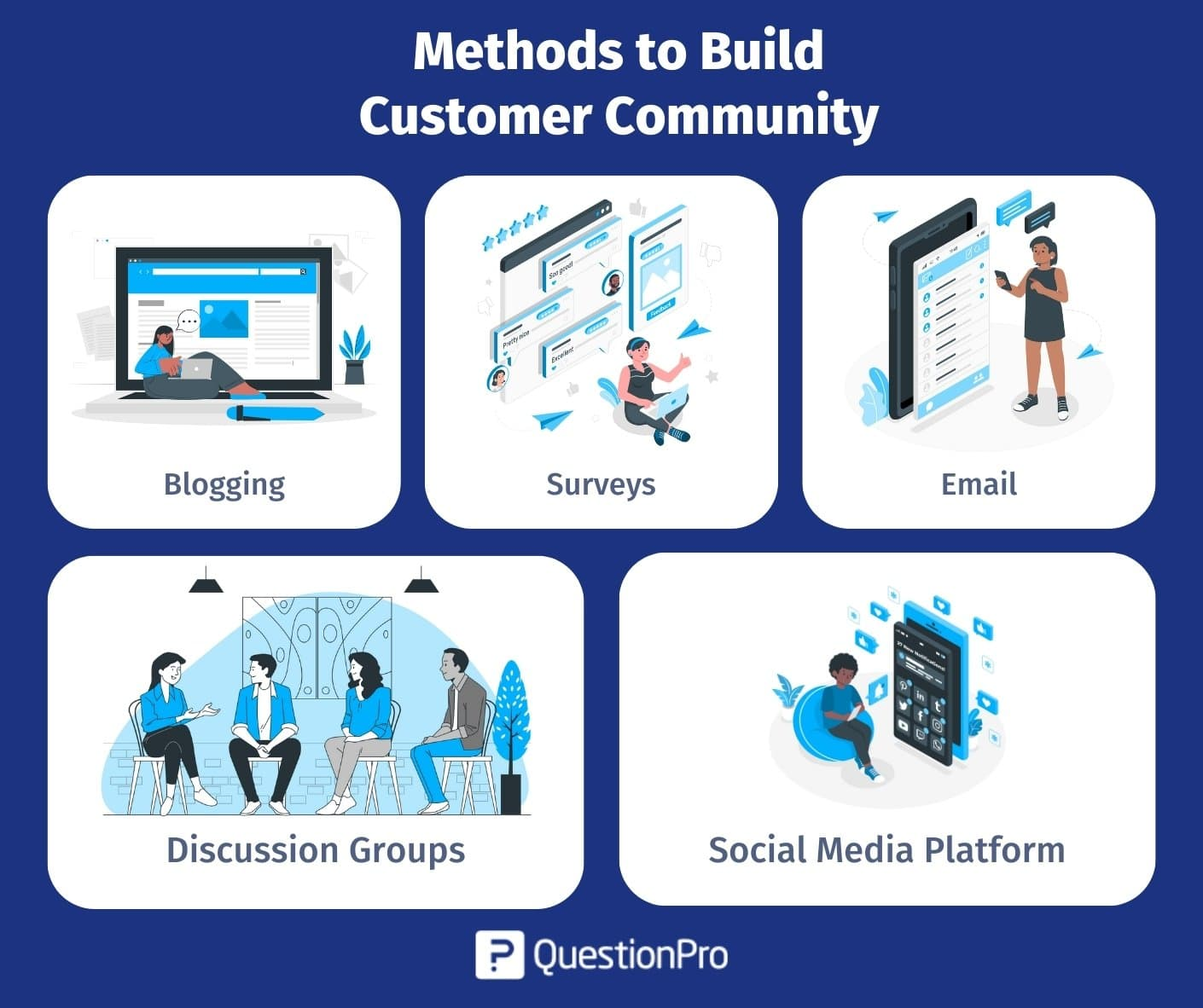An Explainer on Types of Online Communities
Wondering how many types of online communities there are? This guide explores 7 different online communities along with their unique purposes and shared goals.
Wondering how many types of online communities there are? This guide explores 7 different online communities along with their unique purposes and shared goals.

Online communities have become a critical part of learning and networking in today’s digital world. These are spaces where people with shared interests, goals, or professions come together virtually to connect and grow. It is estimated that 76% of users actively participate in online communities on platforms such as Reddit, Facebook, Twitter, and others.
Whether you're an educator or business leader, understanding the various types of online communities can help you leverage their full potential.
In this post, we will explore the most common types of online communities, highlighting their unique features and purposes.

Online communities comprise individuals who interact virtually through a shared platform, united by common interests or objectives. Unlike physical communities centered around geography, online communities transcend location and time zone boundaries. This provides flexible, accessible venues for interaction.
These spaces facilitate meaningful communication, resource sharing, and collective problem-solving across education, business, and social spheres. Online communities vary widely in structure and purpose, ranging from informal groups discussing hobbies to formal professional networks that advance career growth.

Below are 7 types of online communities, each with different purposes and goals.
Learning communities are designed around shared educational goals or skill development. These communities bring together learners and educators to collaborate, discuss, and deepen understanding of a subject or set of competencies.
Examples include groups participating in Massive Open Online Courses (MOOCs), cohort-based educational programs, and professional development forums.
These communities support peer-to-peer learning, where members share insights, ask questions, and offer feedback. The goal is to create a collaborative learning environment where everyone can share their thoughts and opinions.
For instance, there are numerous learning communities for university students, each focused on a different subject. They enable the exchange of resources and co-creation of knowledge, boosting motivation and making learning an interactive, collective journey.
Professional networks unite members around industry-specific interests, career development, and knowledge sharing. The goal is to foster connections, provide mentorship opportunities, and exchange best practices.
Popular examples include LinkedIn groups for marketing professionals, specialized Slack channels for software engineers, or virtual associations for healthcare workers.
Such communities provide a platform for ongoing learning and problem-solving that extends beyond formal training. They often include events, webinars, and forums where professionals discuss challenges and innovations. This continual engagement helps members stay updated, expand their network, and gain access to job opportunities.
Support communities are formed to provide emotional, technical, or practical assistance to members who are experiencing similar issues or circumstances. These groups can focus on health conditions, parenting, addiction recovery, or any challenging life situation.
For example, online forums may connect cancer survivors or mental health advocates, offering mutual support.
These communities offer a safe space for sharing personal stories, coping strategies, and encouragement, significantly reducing feelings of isolation. Their power lies in empathy and shared experience, often enhanced by moderated discussion boards and confidential communication channels.

Social or interest-based communities revolve around shared hobbies, passions, or lifestyle interests. Members connect to share tips, stories, creative ideas, or fandom enthusiasm.
Examples include fan groups for TV shows, book clubs, photography circles, or gaming clans. These communities tend to be informal and highly interactive, often utilizing multimedia content and livestreams. They serve dual purposes of socializing and skill sharing without the pressure of formal learning.
Social communities enhance personal identity and belonging through ongoing, enjoyable interactions.
Brand communities gather customers and fans around a specific company, product, or service. They foster deep emotional connections, loyalty, and engagement. These communities enable customers to share experiences, provide product feedback, and support one another with troubleshooting tips.
Examples range from user forums for tech gadgets to Facebook groups of product enthusiasts. These communities also serve as marketing amplifiers, providing brands with valuable insights and organic advocacy.
Below are some ways to build customer communities.

Communities of Practice comprise professionals dedicated to advancing their shared craft or discipline. These groups focus on collective learning through knowledge exchange, problem-solving, and best practice sharing.
Examples include educator networks, medical specialist groups, and IT professional guilds. A CoP facilitates continuous professional development via discussions, webinars, and collaborative projects.
Membership often involves sustained interaction and commitment, resulting in emergent expertise that exceeds what individuals can achieve alone. These communities are key to innovation and quality improvement within their respective professions.
Hybrid communities blend attributes from multiple types to offer flexible, rich experiences. They can combine formal learning with professional networking, support with socializing, or brand engagement with educational resources. These communities reflect modern, multifaceted user needs and encourage broad participation across interests.
Many platforms support hybrid models, enabling users to seamlessly move between courses, discussion groups, and social functions. This integrated approach increases engagement by addressing various learning, connection, and support preferences within a single environment.
Now that you are familiar with common online communities, it’s time to learn how to engage with them effectively. Since every community has different dynamics, you must know how to address them accordingly.
Here are some best practices that can help you significantly:
Meaningful conversations are the backbone of any vibrant online community. Encouraging members to share insights and ask questions creates an active environment where everyone feels heard and valued.
Use open-ended questions that spark thoughtful responses and promote dialogue beyond yes/no answers. For example, instead of asking “Did you like the training?”, try “How has this training changed the way you approach your work?”
This approach helps deepen member engagement and build connections through shared experiences.

Setting clear, transparent guidelines ensures that members understand the expected behaviors and the type of content that is welcome. Community guidelines create a safe and respectful environment that promotes positive interactions.
Active moderation is essential to uphold these standards. This includes monitoring discussions, addressing potential issues promptly, and managing conflicts effectively. Empowering members to report inappropriate behavior further strengthens the sense of security and trust within the community.
Regular events, such as webinars, workshops, Q&A sessions, or live chats, breathe life into online communities. These events provide members with opportunities for real-time engagement, skill development, and networking, thereby enhancing both learning and social connections.
You can incorporate interactive elements, such as polls or breakout rooms, during these events to keep the audience engaged and foster interaction. Advance promotion and clear scheduling increase attendance and excitement, helping the community feel timely and relevant.
Live streaming events offer an immediate and authentic way for members to connect with community leaders and peers. Real-time interaction creates dynamic conversations, boosts engagement, and humanizes the community experience.
Hosting live Q&As, behind-the-scenes tours, or expert interviews with live chat allows members to participate actively, ask questions, and get instant feedback. Well-planned and smoothly executed live streams foster deeper member loyalty and create lasting, memorable experiences.
Online communities come in many forms, each fulfilling unique roles of learning, networking, support, and social connection. Recognizing these types empowers creators and participants to build tailored, effective communities that foster engagement and growth.
AI-powered tools like Coursebox enable educators and organizations to create interactive, engaging online courses with integrated community features. The platform provides personalized learner feedback and interactive discussion forums, which facilitate collaboration and active participation among members.

Coursebox seamlessly integrates course delivery with rich community features, enabling training providers and educators to create thriving digital ecosystems where learners can collaborate and succeed. Sign up for free now to get started!
Online communities can be categorized by their core purpose. Learning communities focus on education and collaboration, professional networks aim for career development and knowledge sharing, support communities offer emotional or practical assistance, and interest-based communities are built around hobbies or passions. Understanding these types enables community managers to tailor engagement strategies that best meet their audience's needs and objectives.
Learning communities provide a collaborative environment where learners share knowledge, ask questions, and support one another’s growth. They foster social learning and improve retention by creating peer accountability and real-world application opportunities. Whether part of MOOCs or corporate training programs, these communities transform solitary learning into an engaging and interactive process that promotes a deeper understanding.
Support communities create safe spaces for individuals facing similar challenges to share experiences and receive emotional encouragement. These groups have proven invaluable in areas such as health, mental wellness, and addiction recovery. The sense of belonging and empathy generated helps reduce isolation and boost resilience in the members.
Brand communities foster a sense of loyalty and trust among customers by facilitating open dialogue, gathering feedback, and providing peer assistance. They provide companies with real-time insights into customer needs and preferences, driving product innovation. For customers, they create a platform to share experiences, get support, and feel part of a larger brand ecosystem.
Coursebox is an AI-powered training platform that enables educators and organizations to create interactive, engaging online courses with integrated community features. It streamlines course creation by converting existing content into structured courses and generates quizzes and assessments instantly. It also offers AI-based grading and real-time learner support through chatbots. These tools facilitate personalized learning journeys, foster collaboration, and encourage active participation.
